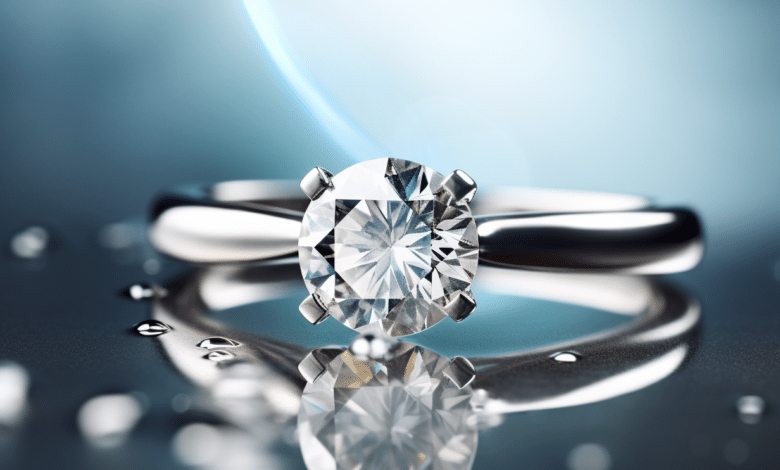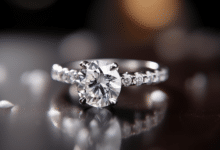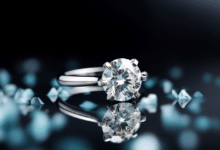8 Unexpected Tips for Choosing the Perfect Engagement Ring Diamond

Choosing the perfect engagement ring diamond is a monumental moment in life – one that deserves careful consideration and attention to detail. While the conventional wisdom of prioritizing the four Cs (cut, color, clarity, and carat) still holds true, there are unexpected factors that can make all the difference in finding a diamond that not only sparkles but also speaks to your unique love story.



1. Unveiling the Captivating World of Diamond Shapes
The shape of a diamond is often overlooked, yet it plays a pivotal role in determining its brilliance and overall aesthetic appeal. While the classic round brilliant cut remains a timeless favorite, venturing into the realm of fancy shapes can unveil a world of possibilities:
- The alluring oval cut elongates the finger, creating an elegant and sophisticated look.
- The regal emerald cut exudes a vintage charm with its clean lines and mesmerizing hall-of-mirrors effect.
- The distinctive princess cut, with its modern square shape and brilliant sparkle, adds a touch of contemporary flair.
- The unique radiant cut combines the best of both worlds – the fire of a round brilliant and the cutting-edge style of a princess cut.
When selecting a diamond shape, consider not only your personal style but also the proportions of your hand,” advises renowned jewelry designer Sarah Quinlan. “A well-proportioned diamond shape can elongate and flatter your finger, creating a truly stunning visual effect.”
2. Unlocking the Secrets of Diamond Brilliance
While carat weight and color are often the primary focal points, it’s the cut quality that truly unlocks a diamond’s brilliance and sparkle. A well-cut diamond reflects light more efficiently, resulting in a dazzling display of fire and scintillation that will take your breath away.
- Look for diamonds with an excellent or ideal cut grade, as these have been meticulously crafted to maximize light performance.
- Explore the world of patented cuts, such as the Hearts on Fire or the Astor Ideal Cut, which boast precise faceting and light-enhancing designs.
- Consider the polish and symmetry grades, as these factors contribute to the overall optical precision and radiant beauty of the diamond.
“A diamond’s cut is its light-reflecting fingerprint,” explains master gemologist Brian Gavin. “By prioritizing cut quality, you’re ensuring that your diamond will dazzle with unparalleled brilliance, fire, and scintillation for a lifetime.”
3. Balancing Budget and Brilliance: The Art of Diamond Pricing
Engagement ring diamond prices can vary significantly, influenced by factors such as carat weight, color, clarity, and cut quality. While it’s tempting to focus solely on carat size, it’s essential to strike a balance between budget and brilliance.
- Consider opting for a slightly smaller carat weight with a higher cut quality, as this can result in a diamond that appears larger and more brilliant to the naked eye.
- Explore diamond shapes like oval or cushion cut, which can create the illusion of a larger carat weight while remaining within your budget.
- Don’t overlook the importance of color and clarity grades – a well-chosen combination can result in a stunning diamond that outshines its higher-priced counterparts.
“It’s all about finding the sweet spot between your budget and the diamond’s overall beauty,” explains diamond expert Brian Gavin. “By prioritizing cut quality and making strategic choices, you can maximize the brilliance and sparkle of your diamond while staying within your desired price range.”
The Ultimate Guide to Choosing the Perfect Engagement Ring Diamond
Selecting the ideal diamond for an engagement ring is a significant decision that combines emotional sentiment with practical considerations. The perfect diamond not only symbolizes your love and commitment but also represents a substantial investment. This comprehensive guide will help you navigate the complex world of diamonds, ensuring you choose a stone that will dazzle for a lifetime.
| Factor | Description | Importance | Tips |
|---|---|---|---|
| Cut | Determines brilliance and sparkle | Highest | Prioritize Excellent or Very Good cuts |
| Clarity | Presence of inclusions or blemishes | High | VS2 or SI1 often offer best value |
| Color | Ranging from D (colorless) to Z (light yellow) | High | G-J provide good balance of color and value |
| Carat | Weight of the diamond | Medium | Consider how it looks, not just the number |
| Shape | Cut style (round, princess, oval, etc.) | Personal preference | Choose based on personal style and finger shape |
| Certification | Independent grading report | Essential | Opt for GIA or AGS certified diamonds |
| Fluorescence | Reaction to UV light | Low to Medium | Can affect price; often unnoticeable in normal light |
| Table Percentage | Width of top facet relative to diameter | Medium | Ideal range: 54-64% for round diamonds |
| Depth Percentage | Height relative to diameter | Medium | Ideal range: 58-64% for round diamonds |
| Symmetry | Alignment of facets | Medium | Look for Very Good or Excellent ratings |
| Polish | Smoothness of diamond surface | Medium | Aim for Very Good or Excellent ratings |
| Price | Cost of the diamond | High | Set a budget and stick to it |
Choosing the perfect engagement ring diamond is a balance of personal preference, quality, and budget. By understanding the key factors that influence a diamond’s beauty and value, you can make an informed decision that results in a stunning and meaningful ring. Remember, while the 4Cs (Cut, Clarity, Color, and Carat) are crucial, factors like certification and personal style should not be overlooked. Take your time, compare options, and don’t hesitate to seek expert advice. With careful consideration, you’ll find a diamond that not only meets your criteria but also captures the essence of your unique love story.
4. The Timeless Allure of Classic Solitaire Engagement Rings
While modern engagement ring designs often incorporate intricate details and intricate settings, the timeless elegance of a classic solitaire ring remains unparalleled. This minimalist yet sophisticated style allows the diamond to take center stage, showcasing its natural beauty and brilliance.
- Opt for a solitaire setting that complements the diamond’s shape, emphasizing its unique facets and proportions.
- Consider classic precious metals like platinum or 18k gold, which provide a stunning contrast to the diamond’s sparkle while ensuring lasting durability.
- Embrace the simplicity of a solitaire ring, allowing the diamond’s brilliance to be the focal point and creating a look that transcends trends and styles.
“A classic solitaire engagement ring is the epitome of timeless elegance,” says renowned jewelry designer David Yurman. Its understated beauty allows the diamond to shine, creating a captivating and enduring symbol of love that will never go out of style.
5. Embracing Sustainable and Ethical Diamonds
In today’s conscious consumer landscape, an increasing number of couples are prioritizing sustainable and ethical diamond choices. From lab-grown diamonds to responsibly sourced natural diamonds, these options not only offer a guilt-free luxury but also contribute to a more socially and environmentally responsible industry.
- Lab-grown diamonds are chemically, physically, and optically identical to their natural counterparts, offering a sustainable and ethical alternative.
- Look for diamonds that are certified by organizations like the Responsible Jewellery Council or the Kimberley Process, ensuring they are conflict-free and ethically sourced.
- Consider vintage or antique diamond rings, which not only possess a unique charm but also promote sustainability by giving new life to existing diamonds.
Choosing an ethical diamond is not just a matter of personal preference; it’s a statement of values and a commitment to a more responsible future for the industry,” explains sustainable jewelry advocate Dorothée Gizenga. “By making conscious choices, you can own a symbol of love that aligns with your principles and contributes to positive change.”
6. Embracing Personalization and Customization
In an era where individuality is celebrated, engagement rings are no longer confined to traditional norms. Couples are increasingly seeking ways to infuse their unique personalities and love stories into their ring designs, creating truly one-of-a-kind pieces that reflect their journey together.
- Work with a skilled jeweler to design a custom ring that incorporates your favorite gemstones, metal choices, or intricate details.
- Consider incorporating meaningful symbols or motifs that hold personal significance, such as engraved initials or a representation of your shared interests.
- Explore the world of bespoke jewelry, where master craftsmen bring your vision to life, creating a truly unique and cherished heirloom.
“A custom engagement ring is more than just a piece of jewelry; it’s a wearable expression of your love story,” says renowned jewelry designer Monique Péan. “By collaborating with skilled artisans, you can create a ring that perfectly captures the essence of your relationship, making it a true masterpiece of love and craftsmanship.”
7. Embracing the Unconventional: Alternative Engagement Ring Styles
While diamonds have long been the traditional choice for engagement rings, an increasing number of couples are embracing alternative gemstones and styles that reflect their unique personalities and preferences.
- Consider vibrant and eye-catching gemstones like sapphires, rubies, or emeralds, which offer a bold and distinctive alternative to diamonds.
- Explore unique ring designs that incorporate intricate metalwork, unexpected shapes, or unconventional settings.
- Embrace the concept of a non-traditional engagement ring, such as a vintage or antique piece with a rich history and one-of-a-kind charm.
“An engagement ring should be a reflection of your personal style and the unique bond you share,” says jewelry designer Jade Trau. “By breaking away from conventions and embracing alternative styles, you can create a truly memorable and meaningful symbol of your love that defies expectation.”
8. The Power of Storytelling: Crafting a Meaningful Legacy
Ultimately, the perfect engagement ring is not just about the diamond or the design; it’s about the story it represents and the legacy it will create. Every ring carries a narrative, a tapestry woven from the threads of love, commitment, and shared experiences.
- Embrace the symbolism behind the ring, understanding that it represents the unbreakable bond you share with your partner.
- Create your own traditions and rituals surrounding the ring, infusing it with personal meaning and significance.
- Envision the ring as an heirloom to be passed down through generations, carrying the story of your love for generations to come.
“An engagement ring is more than just a piece of jewelry; it’s a tangible symbol of your love story,” says renowned jewelry historian Vivienne Becker. “By understanding the deeper meaning behind the ring and creating your own traditions, you’ll imbue it with a sense of legacy that will endure for generations to come.”
In the end, choosing the perfect engagement ring diamond is a journey of self-discovery, a celebration of love, and a testament to the enduring power of commitment. By embracing these unexpected tips and considering factors beyond the conventional, you’ll not only find a diamond that captivates the eye but also one that speaks to the depths of your heart, creating a lasting symbol of your love that will shine brightly for eternity.
The Diamond That Sparked a Revolution: Elizabeth Taylor’s Legendary Ring
In the glittering world of Hollywood, few stars shone as brightly as Elizabeth Taylor. Her love for diamonds was legendary, but it was one particular stone that would change the landscape of engagement rings forever.
In 1968, Richard Burton presented Elizabeth with what would become one of the most famous engagement rings in history – the Krupp Diamond. This astonishing 33.19-carat Asscher cut diamond was not only a testament to their passionate love affair but also a pivotal moment in diamond engagement ring history.
The Krupp Diamond, later renamed the Elizabeth Taylor Diamond, was exceptional for its size and quality. Its impressive dimensions and flawless clarity set a new standard for engagement rings, inspiring countless couples to dream bigger.
Elizabeth often wore this magnificent ring in her films and public appearances, inadvertently becoming a trendsetter. The visibility of such an extraordinary diamond on the hand of one of the world’s most beautiful women sparked a revolution in engagement ring preferences. Suddenly, bigger and bolder became the norm, with many brides-to-be aspiring to have a ring that echoed the glamour of Taylor’s iconic stone.
This ring not only symbolized the Burton-Taylor romance but also marked a shift in how people viewed engagement rings. It transformed them from simple tokens of affection to statements of style and status, forever changing the landscape of bridal jewelry.



FAQ: Choosing the Perfect Engagement Ring Diamond
Question 1: What are the 4C’s of diamonds and how do they affect choosing an engagement ring stone?
Answer 1: The 4C’s of diamonds are the fundamental characteristics that determine a diamond’s quality and value. They include Cut, Color, Clarity, and Carat weight. Cut influences the diamond’s brilliance and sparkle, color is graded from colorless to yellow tint, clarity determines the presence of internal inclusions, and carat measures the diamond’s weight. When selecting an engagement ring stone, it’s crucial to balance these characteristics within your budget. For instance, you might choose a diamond with excellent cut and compromise slightly on color or clarity to get a larger stone. Remember, each characteristic affects the diamond’s appearance and cost, so it’s worth discussing priorities with a jeweler to find the perfect balance for you.
Question 2: Which diamond shape is best for an engagement ring?
Answer 2: The best diamond shape for an engagement ring largely depends on personal preference and your partner’s style. Round brilliant cut remains the most popular due to its classic look and maximum sparkle. However, there are many other intriguing shapes to consider. Princess cut (square) appeals to those seeking a modern look, while cushion cut combines vintage charm with soft lines. Oval and pear shapes can visually elongate fingers. If you’re looking for something unique, consider marquise or heart shapes. Keep in mind that some shapes, like emerald cut, highlight a diamond’s clarity, while others may hide minor imperfections better. Ultimately, the “best” shape is the one that resonates most with your partner’s taste and lifestyle.
Question 3: How much should I spend on a diamond engagement ring?
Answer 3: The amount to spend on a diamond engagement ring is highly individual and depends on your financial situation. The old rule of three months’ salary is outdated. Instead, consider how much you can comfortably spend without compromising other financial goals. Remember, the cost of the ring doesn’t measure the strength of your feelings. Many couples today prefer more modest rings, prioritizing other important expenses like the wedding or a down payment on a house. You can find beautiful rings across a wide price range. Discuss the budget with your partner and don’t hesitate to explore alternatives to traditional diamonds, such as moissanites or colored gemstones, if it helps you stay within your desired budget while still getting a stunning ring.
Question 4: How can I determine the ring size for a surprise proposal?
Answer 4: Determining the correct ring size for a surprise proposal can be tricky, but there are several clever methods. Try “borrowing” one of your partner’s rings worn on the ring finger and take it to a jeweler for sizing. If that’s not possible, ask a friend or family member to discreetly find out the size under some pretext. You could also trace the inner diameter of a ring on paper when your partner isn’t looking. As a last resort, choose a slightly larger size – it’s easier to resize smaller than larger. Some jewelers offer free resizing within a certain period after purchase. Remember that fingers can swell slightly throughout the day, so it’s best to measure in the evening for a more accurate result. If all else fails, you can always have the ring resized after the proposal.
Question 5: Should I choose a natural or lab-grown diamond for an engagement ring?
Answer 5: Choosing between a natural and lab-grown diamond depends on your priorities and values. Lab-grown diamonds have the same physical, chemical, and optical properties as natural ones but cost significantly less. This allows you to get a larger stone for the same budget. They’re also considered a more environmentally friendly choice. Natural diamonds, on the other hand, are valued for their rarity and historical significance. Many people prefer them for the “romance” of their natural origin and potential to increase in value over time. However, it’s important to ensure that natural diamonds are ethically sourced. Discuss this choice with your partner, considering your values and budget. Regardless of your choice, make sure the diamond comes with a quality certificate from a recognized gemological laboratory to ensure you’re getting exactly what you pay for.












